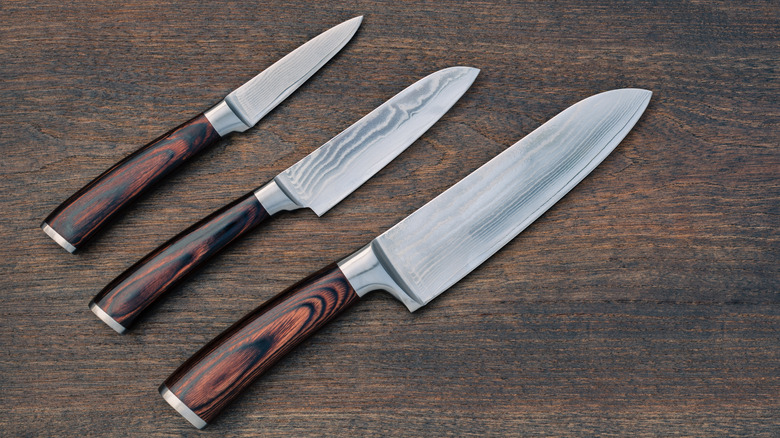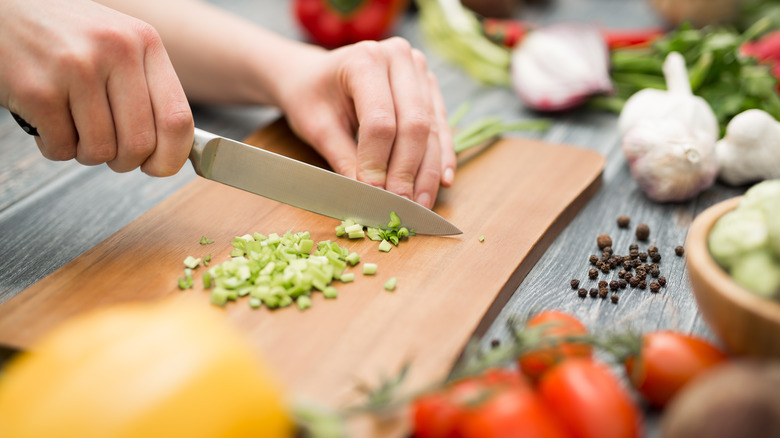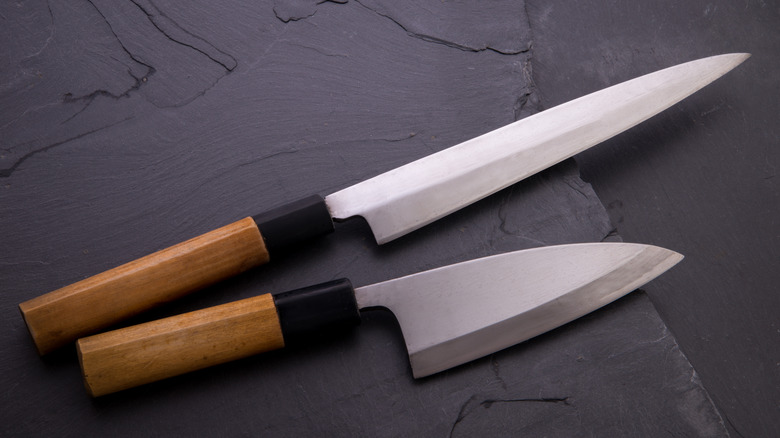The Tiny Versatile Knife All Home Cooks Should Know About
The next time Padma Lakshmi tells a "Top Chef" contestant to pack their knives and go, take a good look as they roll up their cutlery collection. It's a pretty sure bet their personal array will include three basics — a chef's knife, a paring knife, and a serrated knife. But what else? "Top Chef" rules allow contestants to pack up to 12 knives for the competition, so there's a lot of room for customization in that knife roll. It's also where lesser-known personal favorites like the sometimes overlooked Japanese petty knife may come into play.
A favorite among professional chefs, the petty knife is gaining traction among home cooks — and for good reason. Slightly smaller than an American-made utility knife, the blade of a petty knife can range from four to six inches in length. That makes it less cumbersome than a typical chef's knife which can be up to 14 inches in length, so it's a good choice for precise tasks like mincing, chopping, and peeling, and it can also be used in place of a paring knife or boning knife.
Origins of the petty knife
While petty knives may be less well-known than paring or boning knives, they are not new to the market. In fact, the history of the petty knife dates to the mid-19th century. During the Meiji period, when Japan began trading more vigorously with Western nations, Japanese aristocracy became enamored with the French style of cooking. Japan's version of a Western utility knife, the petty knife was created to expedite Japanese chefs' adaptation of French cooking techniques.
Cutlery experts like Josh Donald, owner of San Francisco's Bernal Cutlery and author of "Sharp: The Definitive Introduction to Knives, Sharpening, and Cutting Techniques," believe the name petty knife stems from the French word "petit" which means small in English. While they're not minuscule, even the largest petty knife falls at the smaller end of the scale in terms of blade size. And that's just one consideration. If you're thinking of adding one to your collection, you'll want to consider blade size in addition to material, handle style, and, of course, cost.
What to know about buying a petty knife
When it comes to petty knives, size matters. With a range of four to six inches in length, the smaller knives may be better suited for precision work like brunoise and chiffonade. At the other end of the spectrum, a six-inch petty knife can replace a chef's knife for heavier-duty tasks like slicing and trimming meat, especially in close quarters — line cooks tend to favor them — and they can be more comfortably handled by cooks with smaller hands.
Additionally, handle shape is another consideration when it comes to selecting a petty knife. There are two styles: Japanese (Wa) and Western (Yo). Western style refers to the typical three-rivet flat (rectangular) handle familiar to most American cooks. Japanese-style handles are more rounded and can be shaped like an elongated oval, octagon, or D-shape. Generally, the choice of handle style is a decision based on personal preference.
Then there's the blade: carbon steel or stainless steel? The former is more expensive, but it's also easier to sharpen and will maintain a sharp edge longer than the latter. On the other hand, the thriftier choice, stainless steel, resists corrosion and chipping better than carbon steel. This brings us to cost. Depending on the choice of blade size, handle style, and blade material, a good petty knife can range in price from $60 to more than $200.


